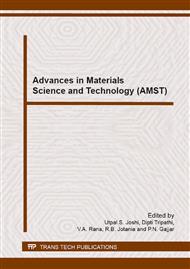p.198
p.203
p.207
p.212
p.216
p.220
p.225
p.229
p.233
Sintering Temperature Effect on the Structural and Electrical Transport Properties of Nanophasic Nd0.7Sr0.3MnO3 Manganite
Abstract:
A systematic investigation of neodymium-based manganite, Nd0.7Sr0.3MnO3, was undertaken with a view to understand the influence of sintering temperature on various physical properties. The materials were prepared by the a soft chemical approach of co-precipitation method by sintering at four different temperatures starting from 700 to 1000 °C, with an interval of 100 °C. X-ray diffraction (XRD), transmission electron microscopy (TEM) and D. C. four-probe resistivity were employed to study the crystal structure, average particle size and electrical property respectively. Analysis of XRD patterns shows that all the samples exhibit single phase orthorhombic crystal structure. We followed William-son Hall approach to calculate the lattice stain (ε).These materials were found to exhibit different metal-insulator transition temperature (TMI) for the different sintering temperature. The value of TMI increases, as the sintering temperature increases, whereas ε decreases. TEM results show that with the increment of sintering temperature, the particle size of the NSMO samples also increases, which plays a key role on electrical transport. To understand the conduction mechanism in metallic and insulating regions of resistivity, various theoretical models are discussed in this communication.
Info:
Periodical:
Pages:
216-219
Citation:
Online since:
November 2013
Authors:
Keywords:
Price:
Сopyright:
© 2014 Trans Tech Publications Ltd. All Rights Reserved
Share:
Citation:


